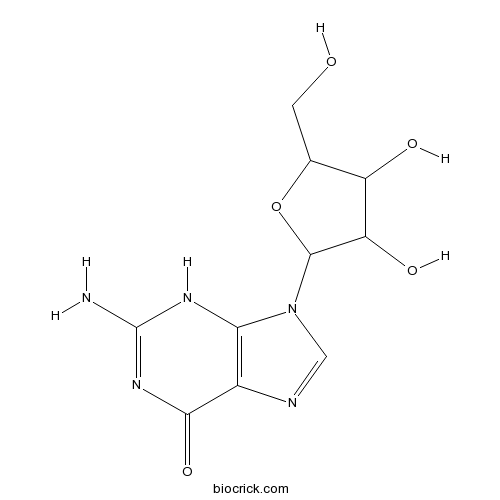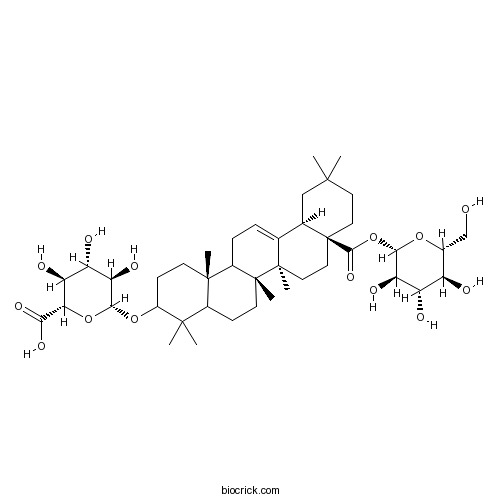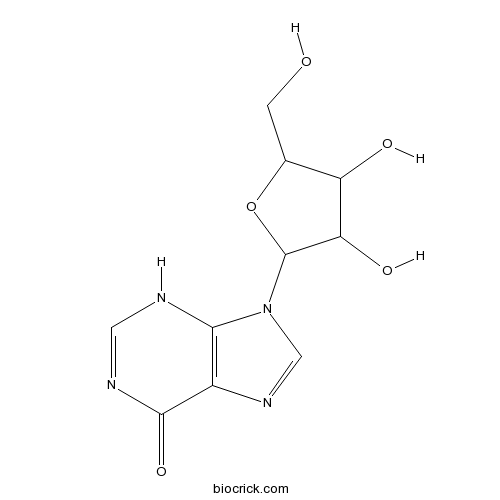Panax japonicus
Panax japonicus
1. The products in our compound library are selected from thousands of unique natural products; 2. It has the characteristics of diverse structure, diverse sources and wide coverage of activities; 3. Provide information on the activity of products from major journals, patents and research reports around the world, providing theoretical direction and research basis for further research and screening; 4. Free combination according to the type, source, target and disease of natural product; 5. The compound powder is placed in a covered tube and then discharged into a 10 x 10 cryostat; 6. Transport in ice pack or dry ice pack. Please store it at -20 °C as soon as possible after receiving the product, and use it as soon as possible after opening.
Natural products/compounds from Panax japonicus
- Cat.No. Product Name CAS Number COA
-
BCN2962
Guanosine118-00-3
Instructions

-
BCN9082
Calenduloside E26020-14-4
Instructions

-
BCN5937
Ginsenoside Ro34367-04-9
Instructions

-
BCN3432
Chikusetsusaponin IVa51415-02-2
Instructions

-
BCN1073
Ginsenoside Re52286-59-6
Instructions

-
BCN1074
Ginsenoside Rd52705-93-8
Instructions

-
BCN3841
Inosine58-63-9
Instructions

-
BCN2683
Chikusetsusaponin IV7518-22-1
Instructions

Identification of certain Panax species to be potential substitutes for Panax notoginseng in hemostatic treatments.[Pubmed: 29772270]
Panax notoginseng (Burkill) F. H. Chen ex C. H. Chow (P. notoginseng) is a highly valued Chinese materia medica having a hemostatic effect and mainly used for the treatment of trauma and ischemic cardiovascular diseases. Stringent growth requirements, weak resistance to insect pests and plant diseases, arsenic contamination and continuous cropping constitute hurdles to further increases in the agricultural production of P. notoginseng. This review focuses on the traditional uses (based on traditional Chinese medicine theory), major chemical components, biological activities, pharmacological properties, geographical distributions and historical development of taxonomy of P. notoginseng and its related species in Panax genus, including Panax japonicus C. A. Meyer (P. japonicus), Panax japonicus C. A. Meyer var. major (Burkill) C. Y. Wu et K. M. Feng (P. japonicus var. major) and Panax japonicus C. A. Meyer var. bipinnatifidus (Seem.) C. Y. Wu et K. M. Feng (P. japonicus var. bipinnatifidus) are reviewed. This review sheds light on the origin herbs of Zhujieshen (ZJS) and Zhuzishen (ZZS), e.g., P. japonicas var japonicas, P. japonicus var. major and P. japonicus var. bipinnatifidus could be used as a substitute for P. notoginseng as hemostatic herbs.
[Effect of saponins extracted from Panax japonicus on inhibiting cardiomyocyte apoptosis by AMPK/Sirt1/NF-κB signaling pathway in aging rats].[Pubmed: 29376267]
To investigate the effects of saponins extracted from Panax japonicus(SPJ) on cardiomyocyte apoptosis in natural aging rats and explore its underlying mechanisms. SD male rats were randomly divided into four groups: young control group, natural aging group, SPJ low dose group and SPJ high dose group, with 10 rats in each group. The rats in natural aging group, SPJ low and high dose groups were respectively treated with normal saline, SPJ 10 and 60 mg•kg-1•d-1 from the beginning of 18 month-old, 6 days per week for 6 months till 24 month-old. Then the animals were sacrificed. Their myocardial morphology changes were observed by using haematoxylin-eoin(HE) staining; cardiomyocyte apoptosis was tested by using Tunel assays; and the protein expression levels of Bcl-2, Bax, IL-1β, TNF-α, AMPK, p-AMPK, Sirt1, and Ac-NF-κB p65 in myocardial tissues of rats were detected by Western blot. The results showed that SPJ could effectively improve the arrangement disorder of myocardial fibers, reduce the infiltration of inflammatory cells and inhibit cardiomyocyte apoptosis in natural aging rats. At the same time, SPJ could significantly inhibit the protein expression of Bax, IL-1β, TNF-α and Ac-NF-κB p65, and increase the expression of Bcl-2, Bcl-2/Bax, p-AMPK/AMPK and Sirt1 in the heart tissues of natural aging rats. SPJ can effectively inhibit cardiomyocyte apoptosis in natural aging rats, and its mechanisms may be related with the regulation of inflammatory reaction by AMPK/Sirt1/NF-κB signaling pathway.
Antitumor immunostimulatory activity of polysaccharides from Panax japonicus C. A. Mey: Roles of their effects on CD4+ T cells and tumor associated macrophages.[Pubmed: 29317237]
None
Clinical judgement perplexed by initially undisclosed use of herbal medicine and unexpected cross-reactivity of immunoassay.[Pubmed: 28866703]
We report a case of symptomatic bradycardia caused by consumption of a Chinese herbal medicine which was initially undisclosed to the attending emergency physician. The scientific name of the herb is Panax japonicus. Electrocardiogram revealed sinus bradycardia. Laboratory tests were normal except for the detection of a high serum digoxin level. Further interrogation of the patient eventually disclosed ingestion of the herb which, however, did not contain any digoxin. Other active ingredients in the herb include various types of ginsenoside. These are digoxin-like substances that had caused the observed false-positive detection of digoxin by fluorescence polarization immunoassay due to cross-reactivity. Our case-report provides an important insight about a blind-spot in the field of laboratory medicine (clinical pathology), namely, the false positive detection of digoxin due to crossreactivity in the immunoassay when we come across digoxin-like substances in clinical scenarios, which has barely received attention in the medical literature. It also conveys a clear educational message that with full understanding of the laboratory methodology and its mechanistic rationale there are actually some tricks-of-the-trade that allow us to optimize the specificity of the biochemical tests and the treatment of digoxin-like substances overdose.


